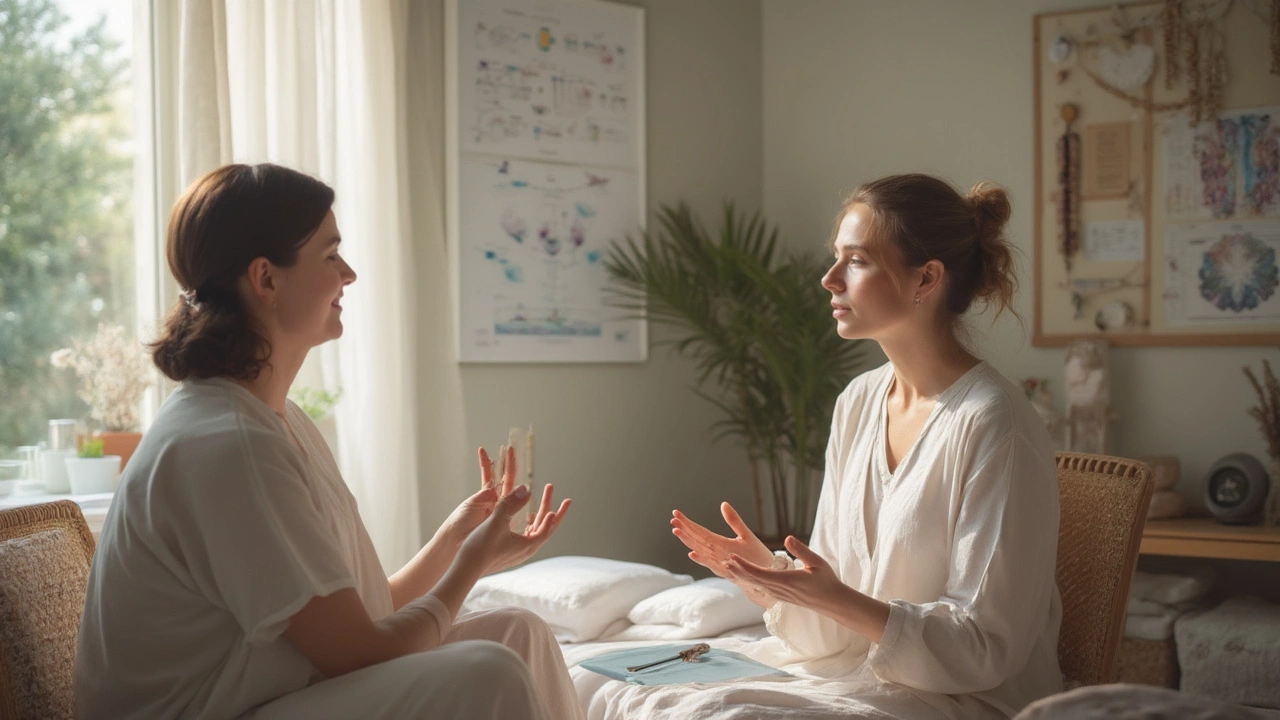Reiki Healing: Science, Stories, and Secrets Explained
 Jul, 13 2025
Jul, 13 2025
If you wander around Adelaide’s quieter suburbs, you’ll spot signs on garden gates boasting ‘Reiki Healing Here.’ It sounds soothing—and mysterious. Chances are, you know someone who swears by reiki. But what’s really going on behind those soft-lit doors? For every Sydney or Perth wellness center advertising reiki, there’s a skeptical eyebrow raised in response. The stories range from astonishing to absurd: hands hovering, energy flows, miraculous recoveries. So is reiki a real healing practice, or just an elaborate placebo? Time to pull back the curtain and look at what we actually know—without the hype and without the cynicism.
The Origins and Ideas Behind Reiki
The story of reiki kicks off in early 20th-century Japan. Mikao Usui, a Buddhist, claimed to have discovered a system of healing through what he called ‘universal life energy.’ He wasn’t alone—energy healing traditions exist from China to Greece—but reiki’s style stuck. When you visit a modern reiki session, it’s pretty quiet. There’s no chanting, no exotic incense—just calm music, dim lights, and hands gently placed above or on your body. Practitioners believe energy flows from the universe, through their hands, and straight to wherever you need it most. That’s the theory, anyway.
Reiki came to the West after World War II, thanks to Hawayo Takata, a Hawaiian lady of Japanese descent. Her versions of the teaching grew legs, reaching Australia before the ‘80s yoga boom. Now, you’ll find reiki classes at most alternative therapy centers and even some hospitals. There are three levels of training, the last of which lets you teach—each one with a ritual ‘attunement’ that’s meant to tune you into this universal force. That’s intriguing, but also opens the door to questions: can this energy be measured? Is there something unique about reiki, or is it just a different flavor of massage or meditation?
Science hasn’t come up with a tool for detecting ‘life energy’ or ki. Still, reiki traditions are chock-full of symbols, hand positions, and a code of ethics called the Five Reiki Principles. No drinking, no anger, be honest—kind of like a self-help manual from the early 1900s. There’s an emphasis on intention and mindfulness, which modern researchers note is similar to many Eastern therapies. Critics, though, can’t overlook the mystical elements: reiki symbols that are taught only to initiates, stories of energy blocks, and the idea that this all works regardless of your beliefs. So, what do people actually experience during a session? That’s where things get interesting.

What Happens During a Session? Real Experiences and Claims
If you’ve never tried reiki, it goes something like this: you show up, settle onto a massage table (clothes on!), and close your eyes. The practitioner places their hands in different positions on or just above your body for several minutes at a time. Most people report warmth, tingling, or deep relaxation—sometimes intense emotions. It feels different from massage; there’s no kneading or pressure, just gentle touch. For some, it’s boring. For others, it’s profound—like coming out of a deep nap you didn’t know you needed. Some see colors or recall old memories; a handful say pain melts away temporarily. There are no laser shows or fireworks—just a gentle, comforting presence.
Here’s where things get hairy. Reiki lovers claim everything from headache relief to faster wound healing. In 2008, a review from the International Journal of Clinical Practice tracked reiki’s growing use in hospitals, including pain management and post-op recovery. Still, most patients, at least in these studies, describe relaxation and stress relief more than miraculous cures. Meanwhile, double-blind medical trials have a history of finding little difference between real reiki and placebo. Critics argue these results are skewed by the ‘care effect’—the healing power of attention and kindness, not energy flows.
One Adelaide woman told me reiki helped her sleep after months of insomnia. She described a warmth in her chest, almost like hope. But is that the energy, or the act of being cared for with undivided attention? A 2019 Australian survey showed about 1 in 10 adults had tried some type of energy medicine—including reiki. That’s a lot of folks seeking something beyond prescriptions and pills. Many leave happy, even if science can’t prove what happened on the table. Hospitals in the US, UK, and even a couple of progressive Australian clinics offer reiki as a complementary therapy. They don’t promise miracles—just another way to boost comfort and help patients relax. At worst, you get an hour’s break from your phone; at best, you might feel more at peace.

Reiki and Science: Searching for Evidence
Now comes the big question: what does science actually say about reiki? The truth is messier than either side wants to admit. Dozens of studies exist, but digging into the data reveals a lot of noise. Some trials show that people feel less pain or anxiety after reiki sessions. But—here’s the kicker—placebo groups (where the practitioner goes through the motions but isn’t ‘attuned’) often get similar results. Take back pain, one of the most studied complaints: a 2017 meta-analysis found reiki help about as much as sham reiki, and not any better than other relaxation techniques. But those who got real or fake reiki generally reported feeling better than people left alone in a waiting room. That points to the human factors—being touched, being listened to, being cared for.
Is there any proof that energy is transferred from practitioner to patient? That remains elusive. There’s never been a peer-reviewed study that could demonstrate detectable energy moving during a session. Measuring such energy—outside spiritual theories—isn’t possible with current technology. Still, researchers haven’t given up. Some neuroscientists are studying the impact of slow, mindful touch on the brain. As of 2024, the consensus is pretty solid: reiki is safe, as long as you use it alongside, not instead of, medical treatment. No adverse effects have been reported beyond the occasional drowsiness.
On the positive side, reiki has a lower dropout rate in studies compared to talk therapy or even massage, probably because the sessions are gentle and never painful. It’s also inexpensive after the first lesson: no equipment, no ongoing fees unless you visit a fancy spa. Here’s a quick table showing some recent findings:
| Study Year | Condition Studied | Result |
|---|---|---|
| 2017 | Chronic pain (Meta-analysis) | Effective at reducing pain compared to waitlist, not better than sham reiki |
| 2020 | Cancer support | Lower anxiety, better sleep in patients; no measurable impact on tumor growth |
| 2021 | Hospital recovery | Improved relaxation and satisfaction reported |
| 2023 | Insomnia in adults | Reported better sleep quality after 4 sessions |
Want to try reiki yourself? A couple of tips: find a certified practitioner with clear ethics. Ask questions. If you have a chronic health problem, keep your doctor in the loop. Nobody credible in the reiki world should tell you to ditch medication or ignore real health advice. Use reiki as a complement, not a replacement. And remember, the vast majority of people who try *reiki healing* leave feeling relaxed—even if the science is still foggy on why.
So, is reiki fact or fiction? There’s no evidence for magical energy, but there’s plenty for the power of a comforting, attentive touch. That, sometimes, is all the healing we need.
